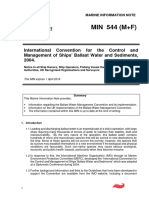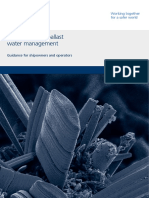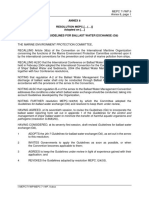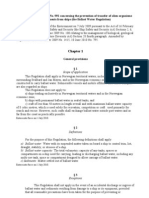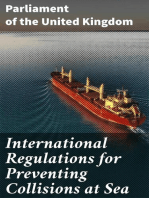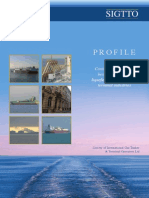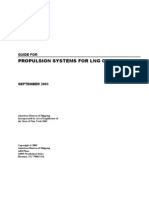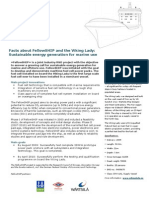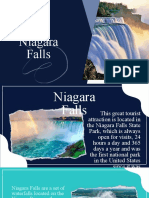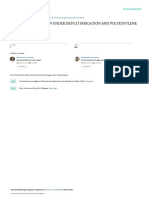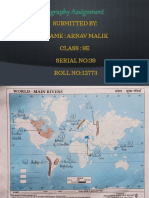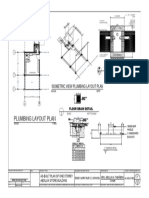0 ratings0% found this document useful (0 votes)
44 viewsShip's Ballast Convention
Ship's Ballast Convention
Uploaded by
bernardinodinoThe International Convention for the Control and Management of Ships' Ballast Water and Sediments establishes standards to prevent the spread of harmful aquatic organisms from one region to another by ships' ballast water. The Convention requires all ships to implement a ballast water management plan and carry out ballast water exchange or treatment. It will enter into force 12 months after ratification by 30 states representing 35% of world merchant shipping tonnage. The Convention specifies ballast water exchange standards and performance standards for maximum number of allowable organisms discharged.
Copyright:
© All Rights Reserved
Available Formats
Download as PDF, TXT or read online from Scribd
Ship's Ballast Convention
Ship's Ballast Convention
Uploaded by
bernardinodino0 ratings0% found this document useful (0 votes)
44 views5 pagesThe International Convention for the Control and Management of Ships' Ballast Water and Sediments establishes standards to prevent the spread of harmful aquatic organisms from one region to another by ships' ballast water. The Convention requires all ships to implement a ballast water management plan and carry out ballast water exchange or treatment. It will enter into force 12 months after ratification by 30 states representing 35% of world merchant shipping tonnage. The Convention specifies ballast water exchange standards and performance standards for maximum number of allowable organisms discharged.
Original Description:
Ship's ballast Convention
Original Title
Ship`s ballast Convention
Copyright
© © All Rights Reserved
Available Formats
PDF, TXT or read online from Scribd
Share this document
Did you find this document useful?
Is this content inappropriate?
The International Convention for the Control and Management of Ships' Ballast Water and Sediments establishes standards to prevent the spread of harmful aquatic organisms from one region to another by ships' ballast water. The Convention requires all ships to implement a ballast water management plan and carry out ballast water exchange or treatment. It will enter into force 12 months after ratification by 30 states representing 35% of world merchant shipping tonnage. The Convention specifies ballast water exchange standards and performance standards for maximum number of allowable organisms discharged.
Copyright:
© All Rights Reserved
Available Formats
Download as PDF, TXT or read online from Scribd
Download as pdf or txt
0 ratings0% found this document useful (0 votes)
44 views5 pagesShip's Ballast Convention
Ship's Ballast Convention
Uploaded by
bernardinodinoThe International Convention for the Control and Management of Ships' Ballast Water and Sediments establishes standards to prevent the spread of harmful aquatic organisms from one region to another by ships' ballast water. The Convention requires all ships to implement a ballast water management plan and carry out ballast water exchange or treatment. It will enter into force 12 months after ratification by 30 states representing 35% of world merchant shipping tonnage. The Convention specifies ballast water exchange standards and performance standards for maximum number of allowable organisms discharged.
Copyright:
© All Rights Reserved
Available Formats
Download as PDF, TXT or read online from Scribd
Download as pdf or txt
You are on page 1of 5
International Convention for the Control and Management of Ships'
Ballast Water and Sediments
Adoption: 13 February 2004
Entry into force: 12 months after ratification by 30 States, representing 35 per cent of world merchant
shipping tonnage. See Status of Conventions
The Convention is divided into Articles; and an Annex which includes technical standards and
requirements in the Regulations for the control and management of ships' ballast water and sediments.
The main features of the Convention are outlined below.
Entry into force
The Convention will enter into force 12 months after ratification by 30 States, representing 35 per cent of
world merchant shipping tonnage (Article 18 Entry into force).
General Obligations
Under Article 2 General Obligations Parties undertake to give full and complete effect to the provisions of
the Convention and the Annex in order to prevent, minimize and ultimately eliminate the transfer of
harmful aquatic organisms and pathogens through the control and management of ships' ballast water
and sediments.
Parties are given the right to take, individually or jointly with other Parties, more stringent measures with
respect to the prevention, reduction or elimination of the transfer of harmful aquatic organisms and
pathogens through the control and management of ships' ballast water and sediments, consistent with
international law. Parties should ensure that ballast water management practices do not cause greater
harm than they prevent to their environment, human health, property or resources, or those of other
States.
Reception facilities
Under Article 5 Sediment Reception Facilities Parties undertake to ensure that ports and terminals where
cleaning or repair of ballast tanks occurs, have adequate reception facilities for the reception of
sediments.
Research and monitoring
Article 6 Scientific and Technical Research and Monitoring calls for Parties individually or jointly to
promote and facilitate scientific and technical research on ballast water management; and monitor the
effects of ballast water management in waters under their jurisdiction.
Survey, certification and inspection
Ships are required to be surveyed and certified (Article 7 Survey and certification) and may be inspected
by port State control officers (Article 9 Inspection of Ships) who can verify that the ship has a valid
certificate; inspect the Ballast Water Record Book; and/or sample the ballast water. If there are concerns,
then a detailed inspection may be carried out and "the Party carrying out the inspection shall take such
steps as will ensure that the ship shall not discharge Ballast Water until it can do so without presenting a
threat of harm to the environment, human health, property or resources."
All possible efforts shall be made to avoid a ship being unduly detained or delayed (Article 12 Undue
Delay to Ships).
Technical assistance
Under Article 13 Technical Assistance, Co-operation and Regional Co-operation, Parties undertake,
directly or through the Organization and other international bodies, as appropriate, in respect of the
control and management of ships' ballast water and sediments, to provide support for those Parties which
request technical assistance to train personnel; to ensure the availability of relevant technology,
equipment and facilities; to initiate joint research and development programmes; and to undertake other
action aimed at the effective implementation of this Convention and of guidance developed by the
Organization related thereto.
Annex - Section A General Provisions
This includes definitions, application and exemptions. Under Regulation A-2 General Applicability: "Except
where expressly provided otherwise, the discharge of Ballast Water shall only be conducted through
Ballast Water Management, in accordance with the provisions of this Annex."
Annex - Section B Management and Control Requirements for Ships
Ships are required to have on board and implement a Ballast Water Management Plan approved by the
Administration (Regulation B-1). The Ballast Water Management Plan is specific to each ship and includes
a detailed description of the actions to be taken to implement the Ballast Water Management
requirements and supplemental Ballast Water Management practices.
Ships must have a Ballast Water Record Book (Regulation B-2) to record when ballast water is taken on
board; circulated or treated for Ballast Water Management purposes; and discharged into the sea. It
should also record when Ballast Water is discharged to a reception facility and accidental or other
exceptional discharges of Ballast Water
Convent
Deposita
IMO Con
Status o
Summar
Status o
country
Convent
Internat
Organiza
Latest R
SOLAS
COLREG
STCW
SAR
SUA
Load Lin
MARPOL
Anti-fou
Ballast W
Liability
Convent
Maritime
Convent
Preventi
Pollution
Other IM
List of C
Convent
Develop
Action D
force da
Pgina 1 de 5 Ballast Water Management
15/12/04 http://www.imo.org/Conventions/mainframe.asp?topic_id=867
The specific requirements for ballast water management are contained in regulation B-3 Ballast Water
Management for Ships:
Ships constructed before 2009 with a ballast water capacity of between 1500 and 5000 cubic
metres must conduct ballast water management that at least meets the ballast water exchange
standards or the ballast water performance standards until 2014, after which time it shall at least
meet the ballast water performance standard.
Ships constructed before 2009 with a ballast water capacity of less than 1500 or greater than
5000 cubic metres must conduct ballast water management that at least meets the ballast water
exchange standards or the ballast water performance standards until 2016, after which time it
shall at least meet the ballast water performance standard.
Ships constructed in or after 2009 with a ballast water capacity of less than 5000 cubic metres
must conduct ballast water management that at least meets the ballast water performance
standard.
Ships constructed in or after 2009 but before 2012, with a ballast water capacity of 5000 cubic
metres or more shall conduct ballast water management that at least meets the standard
described in regulation D-1 or D-2 until 2016 and at least the ballast water performance
standard after 2016.
Ships constructed in or after 2012, with a ballast water capacity of 5000 cubic metres or more
shall conduct ballast water management that at least meets the ballast water performance
standard.
Other methods of ballast water management may also be accepted as alternatives to the ballast water
exchange standard and ballast water performance standard, provided that such methods ensure at least
the same level of protection to the environment, human health, property or resources, and are approved
in principle by IMO's Marine Environment Protection Committee (MEPC).
Under Regulation B-4 Ballast Water Exchange, all ships using ballast water exchange should:
whenever possible, conduct ballast water exchange at least 200 nautical miles from the nearest
land and in water at least 200 metres in depth, taking into account Guidelines developed by IMO;
in cases where the ship is unable to conduct ballast water exchange as above, this should be as
far from the nearest land as possible, and in all cases at least 50 nautical miles from the nearest
land and in water at least 200 metres in depth.
When these requirements cannot be met areas may be designated where ships can conduct ballast water
exchange. All ships shall remove and dispose of sediments from spaces designated to carry ballast water
in accordance with the provisions of the ships' ballast water management plan (Regulation B-4).
Annex - Section C Additional measures
A Party, individually or jointly with other Parties, may impose on ships additional measures to prevent,
reduce, or eliminate the transfer of Harmful Aquatic Organisms and Pathogens through ships' Ballast
Water and Sediments.
In these cases, the Party or Parties should consult with adjoining or nearby States that may be affected
by such standards or requirements and should communicate their intention to establish additional
measure(s) to the Organization at least 6 months, except in emergency or epidemic situations, prior to
the projected date of implementation of the measure(s). When appropriate, Parties will have to obtain
the approval of IMO.
Annex - Section D Standards for Ballast Water Management
There is a ballast water exchange standard and a ballast water performance standard. Ballast water
exchange could be used to meet the performance standard:
Regulation D-1 Ballast Water Exchange Standard - Ships performing Ballast Water
exchange shall do so with an efficiency of 95 per cent volumetric exchange of Ballast
Water. For ships exchanging ballast water by the pumping-through method, pumping
through three times the volume of each ballast water tank shall be considered to meet
the standard described. Pumping through less than three times the volume may be
accepted provided the ship can demonstrate that at least 95 percent volumetric
exchange is met.
Regulation D-2 Ballast Water Performance Standard - Ships conducting ballast
water management shall discharge less than 10 viable organisms per cubic metre
greater than or equal to 50 micrometres in minimum dimension and less than 10 viable
organisms per milliliter less than 50 micrometres in minimum dimension and greater
than or equal to 10 micrometres in minimum dimension; and discharge of the indicator
microbes shall not exceed the specified concentrations.
The indicator microbes, as a human health standard, include, but are not be limited to:
a. Toxicogenic Vibrio cholerae (O1 and O139) with less than 1 colony forming unit (cfu)
per 100 milliliters or less than 1 cfu per 1 gram (wet weight) zooplankton samples ;
b. Escherichia coli less than 250 cfu per 100 milliliters;
c. Intestinal Enterococci less than 100 cfu per 100 milliliters.
Ballast Water Management systems must be approved by the Administration in accordance with IMO
Guidelines (Regulation D-3 Approval requirements for Ballast Water Management systems). These include
systems which make use of chemicals or biocides; make use of organisms or biological mechanisms; or
which alter the chemical or physical characteristics of the Ballast Water.
Pgina 2 de 5 Ballast Water Management
15/12/04 http://www.imo.org/Conventions/mainframe.asp?topic_id=867
Prototype technologies
Regulation D-4 covers Prototype Ballast Water Treatment Technologies. It allows for ships participating in
a programme approved by the Administration to test and evaluate promising Ballast Water treatment
technologies to have a leeway of five years before having to comply with the requirements.
Review of standards
Under regulation D-5 Review of Standards by the Organization, IMO is required to review the Ballast
Water Performance Standard, taking into account a number of criteria including safety considerations;
environmental acceptability, i.e., not causing more or greater environmental impacts than it solves;
practicability, i.e., compatibility with ship design and operations; cost effectiveness; and biological
effectiveness in terms of removing, or otherwise rendering inactive harmful aquatic organisms and
pathogens in ballast water. The review should include a determination of whether appropriate
technologies are available to achieve the standard, an assessment of the above mentioned criteria, and
an assessment of the socio-economic effect(s) specifically in relation to the developmental needs of
developing countries, particularly small island developing States.
Annex- Section E Survey and Certification Requirements for Ballast Water Management
Gives requirements for initial renewal, annual, intermediate and renewal surveys and certification
requirements. Appendices give form of Ballast Water Management Certificate and Form of Ballast Water
Record Book.
Resolutions adopted by the Conference
The Conference also adopted four resolutions:
Conference resolution 1: Future work by the Organization pertaining to the International
Convention for the Control and Management of Ships' Ballast Water and Sediments
Conference resolution 2: The use of decision-making tools when reviewing the standards
pursuant to Regulation D-5
Conference resolution 3: Promotion of technical co-operation and assistance
Conference resolution 4: Review of the Annex to the International Convention for the Control and
Management of Ships' Ballast Water and Sediments
Background
The problem of invasive species is largely due to the expanded trade and traffic volume over the last few
decades. The effects in many areas of the world have been devastating. Quantitative data show the rate
of bio-invasions is continuing to increase at an alarming rate, in many cases exponentially, and new
areas are being invaded all the time. Volumes of seaborne trade continue overall to increase and the
problem may not yet have reached its peak.
Specific examples include the introduction of the European zebra mussel (Dreissena polymorpha) in the
Great Lakes between Canada and the United States, resulting in expenses of billions of dollars for
pollution control and cleaning of fouled underwater structures and waterpipes; and the introduction of the
American comb jelly (Mnemiopsis leidyi) to the Black and Azov Seas, causing the near extinction of
anchovy and sprat fisheries.
The problem of harmful aquatic organisms in ballast water was first raised at IMO in 1988 and since then
IMO's Marine Environment Protection Committee (MEPC), together with the Maritime Safety Committee
(MSC) and technical sub-committees, have been dealing with the issue, focusing in the past decade first
on guidelines and then on developing the new convention.
Going further into history, scientists first recognized the signs of an alien species introduction after a
mass occurrence of the Asian phytoplankton algae Odontella (Biddulphia sinensis) in the North Sea in
1903.
But it was not until the 1970s that the scientific community began reviewing the problem in detail. In the
late 1980s, Canada and Australia were among countries experiencing particular problems with unwanted
species, and they brought their concerns to the attention of IMO's Marine Environment Protection
Committee (MEPC).
In 1991 the MEPC adopted MEPC resolution 50(31) - Guidelines for Preventing the Introduction of
Unwanted Organisms and Pathogens from Ships' Ballast Water and Sediment Discharges; while the
United Nations Conference on Environment and Development (UNCED), held in Rio de Janeiro in 1992,
recognized the issue as a major international concern.
In November 1993, the IMO Assembly adopted resolution A.774(18) - Guidelines for Preventing the
Introduction of Unwanted Organisms and Pathogens from Ships' Ballast Water and Sediment Discharges,
based on the Guidelines adopted in 1991. The resolution requested the MEPC and the MSC to keep the
Guidelines under review with a view to developing internationally applicable, legally-binding provisions.
The 20th Assembly of IMO in November 1997 adopted resolution A.868(20) - Guidelines for the control
and management of ships' ballast water to minimize the transfer of harmful aquatic organisms and
pathogens.
The development of the draft mandatory instrument has been continuing since then until this week's
adoption of the new instrument.
Some examples of aquatic bio-invasions causing major impact are listed in the table, but there are
hundreds of other serious invasions which have been recorded around the world:
Pgina 3 de 5 Ballast Water Management
15/12/04 http://www.imo.org/Conventions/mainframe.asp?topic_id=867
Name Native to Introduced to Impact
Cholera
Vibrio cholerae
(various strains)
Various strains
with broad ranges
South America,
Gulf of Mexico and
other areas
Some cholera epidemics appear to be
directly associated with ballast water
Cladoceran Water
Flea
Cercopagis pengoi
Black and Caspian
Seas
Baltic Sea Reproduces to form very large
populations that dominate the
zooplankton community and clog fishing
nets and trawls, with associated
economic impacts
Mitten Crab
Eiocheir sinensis
Northern Asia Western Europe,
Baltic Sea and
West Coast North
America
Undergoes mass migrations for
reproductive purposes. Burrows into river
banks and dykes causing erosion and
siltation. Preys on native fish and
invertebrate species, causing local
extinctions during population outbreaks.
Interferes with fishing activities
Toxic Algae
(Red/Brown/ Green
Tides)
Various species
Various species
with broad ranges
Several species
have been
transferred to new
areas in ships'
ballast water
May form Harmful Algae Blooms.
Depending on the species, can cause
massive kills of marine life through
oxygen depletion, release of toxins
and/or mucus. Can foul beaches and
impact on tourism and recreation. Some
species may contaminate filter-feeding
shellfish and cause fisheries to be closed.
Consumption of contaminated shellfish
by humans may cause severe illness and
death
Round Goby
Neogobius
melanostomus
Black, Asov and
Caspian Seas
Baltic Sea and
North America
Highly adaptable and invasive. Increases
in
numbers and spreads quickly. Competes
for food and habitat with native fishes
including commercially important
species, and preys on their eggs and
young. Spawns multiple
times per season and survives in poor
water quality
North American
Comb Jelly
Mnemiopsis leidyi
Eastern Seaboard
of the Americas
Black, Azov and
Caspian Seas
Reproduces rapidly (self fertilising
hermaphrodite) under favourable
conditions. Feeds excessively on
zooplankton. Depletes zooplankton
stocks; altering food web and ecosystem
function. Contributed significantly to
collapse of Black and Asov Sea fisheries
in 1990s, with massive economic and
social impact. Now threatens similar
impact in Caspian Sea.
North Pacific
Seastar
Asterias amurensis
Northern Pacific Southern Australia Reproduces in large numbers, reaching
'plague' proportions rapidly in invaded
environments. Feeds on shellfish,
including commercially valuable scallop,
oyster and clam species
Zebra Mussel
Dreissena
polymorpha
Eastern Europe
(Black Sea)
Introduced to:
Western and
northern Europe,
including Ireland
and Baltic
Sea;eastern half of
North America
Fouls all available hard surfaces in mass
numbers. Displaces native aquatic life.
Alters habitat, ecosystem and food web.
Causes severe fouling problems on
infrastructure and vessels. Blocks water
intake pipes, sluices and irrigation
ditches. Economic costs to USA alone of
around
US$750 million to $1 billion between
1989 and 2000
Asian Kelp
Undaria pinnatifida
Northern Asia Southern Australia,
New Zealand, West
Coast of the United
States, Europe and
Argentina
Grows and spreads rapidly, both
vegetatively and through dispersal of
spores. Displaces native algae and
marine life. Alters habitat, ecosystem
and food web. May affect commercial
shellfish stocks through space
competition and alteration of habitat
European Green
Crab
Carcinus maenus
European Atlantic
Coast
Southern Australia,
South Africa, the
United States and
Japan
Highly adaptable and invasive. Resistant
to predation due to hard shell. Competes
with and displaces native crabs and
becomes a dominant species in invaded
areas. Consumes and depletes wide
range of prey species. Alters inter-tidal
rocky shore ecosystem
Pgina 4 de 5 Ballast Water Management
15/12/04 http://www.imo.org/Conventions/mainframe.asp?topic_id=867
Reference: http://globallast.imo.org/poster4_english.pdf
______________
Pgina 5 de 5 Ballast Water Management
15/12/04 http://www.imo.org/Conventions/mainframe.asp?topic_id=867
You might also like
- EXM - Area 2 - 2Document34 pagesEXM - Area 2 - 2Jane Denise RazoNo ratings yet
- Garbage Management PlanDocument26 pagesGarbage Management Plankhanhsonphams100% (5)
- MSDS Lyser RaytoDocument2 pagesMSDS Lyser RaytobarunacesarNo ratings yet
- Prevention of Pollution by Garbage From ShipsDocument5 pagesPrevention of Pollution by Garbage From Shipsrares angNo ratings yet
- Piloting, Seamanship and Small Boat Handling - Vol. VFrom EverandPiloting, Seamanship and Small Boat Handling - Vol. VRating: 5 out of 5 stars5/5 (2)
- Ochure ulstEINDocument4 pagesOchure ulstEINbernardinodino100% (1)
- Manoeuvring BookletDocument29 pagesManoeuvring Bookletbernardinodino100% (4)
- KSB Valve Catelogue PDFDocument78 pagesKSB Valve Catelogue PDFpm2013100% (1)
- The Soils of The LowlandsDocument57 pagesThe Soils of The LowlandsAngelique BernardinoNo ratings yet
- International Convention For The Control and Management of Ships' Ballast Water and Sediments (BWM)Document8 pagesInternational Convention For The Control and Management of Ships' Ballast Water and Sediments (BWM)denis_john_2No ratings yet
- International Convention For The Control and Management of Ships' Ballast Water and Sediments (BWM)Document8 pagesInternational Convention For The Control and Management of Ships' Ballast Water and Sediments (BWM)richard icalaNo ratings yet
- International Convention For The Control and Management of Ships' Ballast Water and SedimentsDocument61 pagesInternational Convention For The Control and Management of Ships' Ballast Water and SedimentsZin Maung TunNo ratings yet
- Ballast Water ManagementDocument3 pagesBallast Water ManagementpaddyinlineNo ratings yet
- Ballast Water Management: S M Tomiz Uddin:1055 Mfa 25, A1MC20180601-A (24) ALAM015268Document9 pagesBallast Water Management: S M Tomiz Uddin:1055 Mfa 25, A1MC20180601-A (24) ALAM015268Taufiq JahanNo ratings yet
- Min 544 (M+F)Document10 pagesMin 544 (M+F)mustafasuliman153No ratings yet
- 213-35824 Understanding Ballast Water Management 0314 tcm155-248816 PDFDocument28 pages213-35824 Understanding Ballast Water Management 0314 tcm155-248816 PDFMihail KolishNo ratings yet
- Understanding Ballast Water Management - 0214 - tcm155-248816 PDFDocument29 pagesUnderstanding Ballast Water Management - 0214 - tcm155-248816 PDFShahid Reza100% (1)
- Annex 4 Week 5Document45 pagesAnnex 4 Week 5Joshua DilaoNo ratings yet
- BWM ExplainedDocument10 pagesBWM ExplainedGaurav ShresthNo ratings yet
- 7.1 Proposed Annex VII - BWM ConventionDocument38 pages7.1 Proposed Annex VII - BWM ConventionDennis IndayNo ratings yet
- RES 0477 de 2012 Aguas de Lastre (Ingles)Document11 pagesRES 0477 de 2012 Aguas de Lastre (Ingles)diego bolivarNo ratings yet
- 1.8 Ballast Water ManagementDocument13 pages1.8 Ballast Water Managementsugam singh PahwaNo ratings yet
- Update On The Implementation of The Ballast Water Management Convention (BWMC), 2004Document17 pagesUpdate On The Implementation of The Ballast Water Management Convention (BWMC), 2004Sanjiv KumarNo ratings yet
- China - Measures For Supervision and Management of Ship Ballast Water and SedimentDocument3 pagesChina - Measures For Supervision and Management of Ship Ballast Water and SedimentMihail KolishNo ratings yet
- Ballast TrainingDocument29 pagesBallast TrainingAkash NairNo ratings yet
- Ballast Water Management ConventionDocument3 pagesBallast Water Management Conventionbeast channelNo ratings yet
- Mar Env:: Protection of The Marine EnvironmentDocument9 pagesMar Env:: Protection of The Marine EnvironmentHaeisy SimsuangcoNo ratings yet
- 2017 Guidelines For Ballast Water Exchange (G6)Document9 pages2017 Guidelines For Ballast Water Exchange (G6)RoNnin MitreaNo ratings yet
- Sewage - RegulationsDocument5 pagesSewage - Regulationsankit.jadhav263No ratings yet
- BWM 2Document3 pagesBWM 2SAMKUMARNo ratings yet
- Force In: Ballast Water Management Convention Enter IntoDocument3 pagesForce In: Ballast Water Management Convention Enter IntovishnuNo ratings yet
- NKK Guidelines On The Installation of Ballast Water Treatment SystemsDocument32 pagesNKK Guidelines On The Installation of Ballast Water Treatment SystemsCharalampos ChatzivasileiouNo ratings yet
- Marpol Annex 1 and 2.NABASADocument9 pagesMarpol Annex 1 and 2.NABASAFreakNo ratings yet
- Ballast Water Management Onboard ShipDocument10 pagesBallast Water Management Onboard ShipAnmol SatyamNo ratings yet
- Ballast Water Convention - Entry Into Force - Rev4Document21 pagesBallast Water Convention - Entry Into Force - Rev4Mihail KolishNo ratings yet
- Ballast Water Management Plan Appendix 4Document2 pagesBallast Water Management Plan Appendix 4Dāvis Dzērve100% (1)
- Annex 4 RESOLUTION MEPC.152 (55) Adopted On 13 October 2006 Guidelines For Sediment Reception Facilities (G1)Document4 pagesAnnex 4 RESOLUTION MEPC.152 (55) Adopted On 13 October 2006 Guidelines For Sediment Reception Facilities (G1)Fisyah ZainonNo ratings yet
- Annex 1 RESOLUTION MEPC.123 (53) Adopted On 22 July 2005 Guidelines For Ballast Water Management Equivalent Compliance (G3)Document4 pagesAnnex 1 RESOLUTION MEPC.123 (53) Adopted On 22 July 2005 Guidelines For Ballast Water Management Equivalent Compliance (G3)Agung SulistyoNo ratings yet
- MARENV Rev. Week 7-8 annex 4Document5 pagesMARENV Rev. Week 7-8 annex 4Noel SantosNo ratings yet
- Lloyds Ballast Water Management Guide PDFDocument28 pagesLloyds Ballast Water Management Guide PDFuser123No ratings yet
- (Prevention Of) Pollution by Sewage From ShipsDocument7 pages(Prevention Of) Pollution by Sewage From ShipsLyka LykaNo ratings yet
- Annex 7 Ballast WaterDocument2 pagesAnnex 7 Ballast Watermarkjames castroNo ratings yet
- BWTT - June 2011 - tcm155-222616Document20 pagesBWTT - June 2011 - tcm155-222616Georgios PapakostasNo ratings yet
- 08-10e Agreement Ballast Water Management StrategyDocument20 pages08-10e Agreement Ballast Water Management StrategyBadHatNo ratings yet
- 08.11 QnaDocument28 pages08.11 QnaJoaquim Michael FurtadoNo ratings yet
- Norway Ballast Water ExchangeDocument18 pagesNorway Ballast Water ExchangeLoka Radhakrishna Narasaiah0% (1)
- Hong Kong Konventionen Ship RecyclingDocument47 pagesHong Kong Konventionen Ship Recyclinglailaiza magfirohNo ratings yet
- 3-1 Under Keel ClearanceDocument8 pages3-1 Under Keel ClearanceErsin SaltNo ratings yet
- BWM 2-Circ 62Document4 pagesBWM 2-Circ 62sonerNo ratings yet
- Ballast Water Management, Mepc 127Document16 pagesBallast Water Management, Mepc 127Eshwar BabuNo ratings yet
- GMP - UniverseDocument27 pagesGMP - UniverseShahid Ali Syed100% (1)
- MARPOL Annex 2Document7 pagesMARPOL Annex 2Leo Keith JocsonNo ratings yet
- Pol-014 BWMDocument34 pagesPol-014 BWMefendi kaptanNo ratings yet
- Ballast Water Management Surveyor GuidelinesDocument10 pagesBallast Water Management Surveyor GuidelinesNagy A.M. ElnadyNo ratings yet
- 20 January 2017 Standard Europe Circular Ballast Water Management ConventionDocument5 pages20 January 2017 Standard Europe Circular Ballast Water Management ConventionvdevivNo ratings yet
- Marpol SummaryDocument5 pagesMarpol SummaryrigelNo ratings yet
- Technical InformationDocument6 pagesTechnical InformationAnnesNo ratings yet
- Marpol - SewageDocument5 pagesMarpol - SewageRustam RiyadiNo ratings yet
- Regulations On The Prevention and Control of Ship Pollution in The Jiangsu Section of The Yangtze RiverDocument14 pagesRegulations On The Prevention and Control of Ship Pollution in The Jiangsu Section of The Yangtze RiverSM OHNNo ratings yet
- 2015 VGP Checklist - Rev0Document9 pages2015 VGP Checklist - Rev0Takis RappasNo ratings yet
- Chetan Ballast Water ExchangeDocument13 pagesChetan Ballast Water ExchangechetandumbreNo ratings yet
- Port State Control 1 YearDocument11 pagesPort State Control 1 YearSidharth PrakashNo ratings yet
- International Regulations for Preventing Collisions at SeaFrom EverandInternational Regulations for Preventing Collisions at SeaNo ratings yet
- Us Navy Selects Ion Track S Vaportracer To Fight Terrorism, Improve Force ProtectionDocument2 pagesUs Navy Selects Ion Track S Vaportracer To Fight Terrorism, Improve Force ProtectionbernardinodinoNo ratings yet
- Equipos Automaticos de Deteccion de ExplosivosDocument12 pagesEquipos Automaticos de Deteccion de ExplosivosbernardinodinoNo ratings yet
- Explosives-Detection Systems: Configuration Management and Performance Verification ofDocument20 pagesExplosives-Detection Systems: Configuration Management and Performance Verification ofbernardinodinoNo ratings yet
- Republic of The Marshall Islands Office of The Maritime AdministratorDocument5 pagesRepublic of The Marshall Islands Office of The Maritime AdministratorbernardinodinoNo ratings yet
- Advisory: What Should You Do?Document1 pageAdvisory: What Should You Do?bernardinodinoNo ratings yet
- Explosives Sampling SystemDocument2 pagesExplosives Sampling SystembernardinodinoNo ratings yet
- Equipos Automaticos de Deteccion de ExplosivosDocument12 pagesEquipos Automaticos de Deteccion de ExplosivosbernardinodinoNo ratings yet
- ISPS Clause For Voyage Charter PartiesDocument3 pagesISPS Clause For Voyage Charter PartiesbernardinodinoNo ratings yet
- 2000 - NIJ - A Guide For Explosion and Bombing Scene InvestigationDocument64 pages2000 - NIJ - A Guide For Explosion and Bombing Scene Investigationfaradio2100% (2)
- Gastech: Kazuaki YuasaDocument16 pagesGastech: Kazuaki YuasabernardinodinoNo ratings yet
- World S First Large Size: LNG Carrier With Electric PropulsionDocument2 pagesWorld S First Large Size: LNG Carrier With Electric PropulsionbernardinodinoNo ratings yet
- SIGTTO BookletDocument6 pagesSIGTTO BookletbernardinodinoNo ratings yet
- LNGDocument2 pagesLNGbernardinodinoNo ratings yet
- 112 LNG Propulsion GuideDocument74 pages112 LNG Propulsion Guidebernardinodino100% (2)
- Facts FellowSHIP and Viking Lady2Document2 pagesFacts FellowSHIP and Viking Lady2bernardinodinoNo ratings yet
- Propulsion Systems For Future LNG CarriersDocument4 pagesPropulsion Systems For Future LNG CarriersbernardinodinoNo ratings yet
- ECDIS Certifcate For OfficersDocument2 pagesECDIS Certifcate For OfficersbernardinodinoNo ratings yet
- Freefall Lifeboats: in Maritime EquipmentDocument4 pagesFreefall Lifeboats: in Maritime Equipmentbernardinodino100% (1)
- Good Practice: Enclosed Lifeboat LaunchingDocument20 pagesGood Practice: Enclosed Lifeboat Launchingbernardinodino0% (1)
- Maritimenewzealand Accidente RenaDocument20 pagesMaritimenewzealand Accidente RenabernardinodinoNo ratings yet
- Post OPA-90 Vessel Oil Transfer Spill Prevention: The Effectiveness of Coast Guard EnforcementDocument22 pagesPost OPA-90 Vessel Oil Transfer Spill Prevention: The Effectiveness of Coast Guard EnforcementbernardinodinoNo ratings yet
- Worksheet23 MaritimeDocument2 pagesWorksheet23 MaritimebernardinodinoNo ratings yet
- Total Water Management Practices For A Sustainable Future (Neil S Grigg American Water Works Association) (Z-Library)Document315 pagesTotal Water Management Practices For A Sustainable Future (Neil S Grigg American Water Works Association) (Z-Library)suonsovannakaNo ratings yet
- Chennai Disaster Management Plan With Zonal Ready ReckonersDocument725 pagesChennai Disaster Management Plan With Zonal Ready ReckonersVaishnavi JayakumarNo ratings yet
- Geography Review in 20 Minutes A Day (PDFDrive)Document290 pagesGeography Review in 20 Minutes A Day (PDFDrive)Ankit ShuklaNo ratings yet
- 3 Pond Design and LayoutDocument59 pages3 Pond Design and Layoutditano.mm68No ratings yet
- TMW 2020 - Consolidation Modeling For Design of Complex In-Pit TSFDocument11 pagesTMW 2020 - Consolidation Modeling For Design of Complex In-Pit TSFgushiken SantosNo ratings yet
- IES OBJ Civil Engineering 2000 Paper IIDocument14 pagesIES OBJ Civil Engineering 2000 Paper IItom stuartNo ratings yet
- Area Hijau Edukatif Di SD-SMK Perti, Tanjung Gedong, Grogol, Jakarta BaratDocument8 pagesArea Hijau Edukatif Di SD-SMK Perti, Tanjung Gedong, Grogol, Jakarta BaratSubhan AliNo ratings yet
- EcodesDocument2 pagesEcodesFritz Curt PeñalosaNo ratings yet
- Niagara FallsDocument26 pagesNiagara FallsSteven JimenezNo ratings yet
- Design - Aspect Value Al - Method Ranking RelevanceDocument16 pagesDesign - Aspect Value Al - Method Ranking RelevanceThinh OnNo ratings yet
- Case Brief An Unequal Fight Dec 2020 VCLPDocument25 pagesCase Brief An Unequal Fight Dec 2020 VCLPShreya YadavNo ratings yet
- UPLB - Farm Irrigation and DrainageDocument18 pagesUPLB - Farm Irrigation and DrainageVanessa Mae LacamentoNo ratings yet
- SeaQuantum BrochureDocument12 pagesSeaQuantum BrochureLeo TvrdeNo ratings yet
- 机经 231101 阅读P2 Ocean CurrentsDocument3 pages机经 231101 阅读P2 Ocean CurrentsDavid ZhaoNo ratings yet
- Eggplant Production Under Deficit Irrigation and Polyethylene MulchDocument15 pagesEggplant Production Under Deficit Irrigation and Polyethylene MulchEMEKA IKECHUKWUNo ratings yet
- Geography Assignment: Submitted By: NAME:,.... U. VMALII (Class:9E SER.u - U., N0:39 ROLL N0:12773Document4 pagesGeography Assignment: Submitted By: NAME:,.... U. VMALII (Class:9E SER.u - U., N0:39 ROLL N0:12773ArnavNo ratings yet
- Isometric View Plumbing Layout PlanDocument1 pageIsometric View Plumbing Layout PlanMark Ruby OpawonNo ratings yet
- Central Park Running MapDocument1 pageCentral Park Running MapglobalvagrantNo ratings yet
- 2011-2012 Fund - District Wise - UpdatedDocument32 pages2011-2012 Fund - District Wise - UpdatedpupbankuraNo ratings yet
- HOSPITAL Engineering Services: Advanced Services BY Soundarya Batna 18C31C4016Document24 pagesHOSPITAL Engineering Services: Advanced Services BY Soundarya Batna 18C31C4016Soundarya BatnaNo ratings yet
- Ss 1 Geography Week 4 - 10Document30 pagesSs 1 Geography Week 4 - 10ojo ayodeji johnsonNo ratings yet
- Volume II Institutional Setup Coordination GuideDocument100 pagesVolume II Institutional Setup Coordination GuidejemalNo ratings yet
- 10 1108 - Whatt 06 2020 0041Document21 pages10 1108 - Whatt 06 2020 0041suzy adelNo ratings yet
- McKinney and Savitsky - Chapter 4 - GroundwaterDocument94 pagesMcKinney and Savitsky - Chapter 4 - GroundwaterTsega HaileslassieNo ratings yet
- ESP Reading Comprehension EnvironmentDocument171 pagesESP Reading Comprehension Environmentcarolina100% (1)
- Drexel Pinene II OMRI Listed LabelDocument2 pagesDrexel Pinene II OMRI Listed Labelmocano26No ratings yet















